News
What are Kamiks and how are they made?
Kamiks – the traditional Seal Skin and Caribou boots of the Inuit
I will always remember the first time I saw “kamiks”. They were made by Mona Netser, a traditional sealskin seamstress and designer from Coral Harbour, Nunavut. We were in Estonia where she was giving a workshop to Estonian artists on traditional Inuit seal skin products. Although I was in awe of their beauty, I became even more impressed when she filled me in on the cultural importance of kamiks.
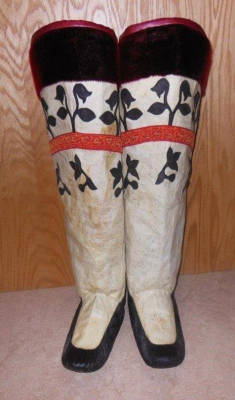
Kamiks are handcrafted boots worn by the Inuit people, made from caribou or sealskin. Kamiks are traditionally made by Inuit women, and the method is passed on from elders to the younger seamstresses. The process of making kamiks is a lengthy one beginning with the preparation of the animal skin. Traditionally, caribou or sealskin is chewed until it is the right suppleness and shape. Because the skin is thick, seamstresses traditionally would use bone needles but now, strong metal needles are used. Great sewing skill, strength and patience is needed to work with the thick skin as it is so important the stitching is secure. Traditionally, the women used animal sinew as thread but today, seamstresses use wax thread.
The kamik covers the foot and goes halfway up the calf of the leg. The Inuit wore two to five layers of footwear depending on what they were planning to do and what the weather and ground was like. The layers included an inner slipper, stocking or liner, boot, and over slipper. The special wool stocking or socks are called duffle socks, and they are just as important aesthetically as they are in keeping the feet warm. They will feature colourful, intricate patterns stitched into the sock. Patterns are often geometric or floral.
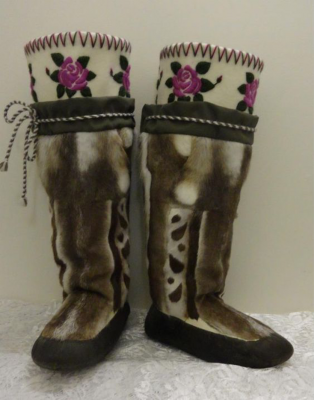
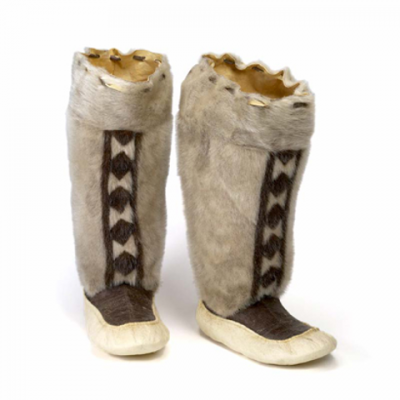
There is cultural significance in the design and decoration of the kamiks revealing the designer’s lineage, gender, abilities and regional relationships. For example, even though they may come from different geographical communities, traditionally the men’s and boy’s kamiks have vertical patterns on the shaft, whereas the women’s and girl’s have horizontal ones.
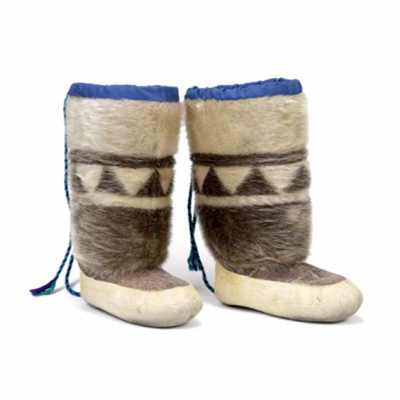
Functionally, the kamik is lightweight. This has enabled the hunter to move quietly on his hunt as he approaches his prey. Like many Indigenous relationships with animals, It is said that Inuit hunters believed that the success of the hunt depended not only on skill but on the respect shown to the animals they hunted. Different rules applied to relationships with animals of the land versus animals of the sea. Therefore, if they were hunting seal they would wear seal skin kamiks, and if hunting on land they would wear caribou kamiks. This was done so as not to offend the animals or spirits. There was also a practical reason for doing this. Sealskin kamiks were better hunting on the ice because they were water resistant, warm and durable. Caribou kamiks were not good on the ice because they would get wet but were warmer in the snow because their fur was thicker than seal.
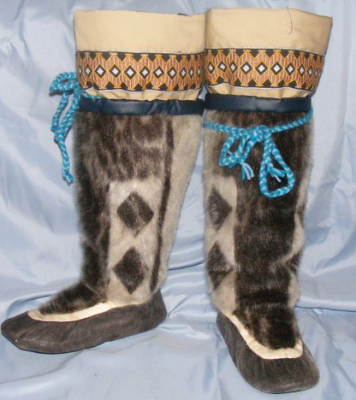
Kamiks are still popular today. Inuit women sew kamiks for their families but also Inuit crafters and designers make their kamiks available for sale on various on line shopping sites and retail outlets. Kamiks are a beautiful example of the beauty of functional clothing made by the Inuit. Check out the Proudly Indigenous Crafts & Designs shop to connect with a crafter that makes these beautiful traditional kamiks.
Sources:
https://www.athropolis.com/arctic-facts/fact-inuit-boots.htm


 Français
Français 简体中文
简体中文 ᐃᓄᒃᑎᑐᑦ
ᐃᓄᒃᑎᑐᑦ